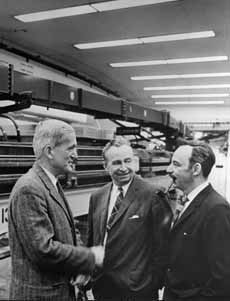 The following is a news account discussing the explosion at the Cambridge Electron Accelerator on
July 5, 1965. It had been in operation for about two years at the time.
The following is a news account discussing the explosion at the Cambridge Electron Accelerator on
July 5, 1965. It had been in operation for about two years at the time. The following is a news account discussing the explosion at the Cambridge Electron Accelerator on
July 5, 1965. It had been in operation for about two years at the time.
The following is a news account discussing the explosion at the Cambridge Electron Accelerator on
July 5, 1965. It had been in operation for about two years at the time.
Fortunately, I was in Minnesota at the Williams Laboratory of Nuclear Physics when it happened. If I'd stayed at MIT, I probably would have been one of the dead or injured, because the beamline I was working on was only about 15 feet away from that bubble chamber.
It was enormous, a cube of iron about eight or ten feet on a side. There were openings where particle beams could enter and emerge, and windows where cameras could see in. It weighed far more than the overhead cranes could deal with, so it had a set of hydraulic cylinders that let it "walk".
I crawled all over it one afternoon, curious about its construction. Fortunately, it was in a good mood that day; or perhaps merely sleeping.
Seven injured; one dead
By Bob Horvitz
For acts of heroism following the hydrogen explosion and fire in the Experimental Hall of the accelerator in Cambridge last July 5, Fred E. Gale has been named to receive the U.S. Atomic Energy Commission Citation.
Gale, a cryogenics technician on the staff of the Cambridge Electron Accelerator, risked serious injury after being hurled by the explosion through a doorway, and rushed back to the scene of the explosion and fire where he turned off the helium compressor and led three of the injured to safety.
Eight persons were injured in the explosion; three of them seriously. One died two weeks later. Damages were estimated at $1 million.
The explosion and fire occurred at 3:32 am on July 5, in the region of and adjacent to the liquid hydrogen bubble chamber in the Cambridge Electron Accelerator Experimental Hall. By 4:00 am several intense local fires were burning on the floor of the Hall, and insulation from the severely damaged roof was burning. The fire on the floor was contained by 5:00 am, but water was continued on the burning roof until 10:00 am or later.
Major damage occurred to the roof, which was formed of light, precast reinforced concrete panels topped by a layer of insulation and a tar and gravel weather topping. The explosion lifted and dropped the concrete panels on the girders where the panels broke and shattered, dropping large quantities of rubble and tar on the floor and contributing significantly to damage of equipment. The burning roof required the use of much water which flooded the floor to a 14 inch depth and also added to equipment damage.
Danger from falling. debris forbade access to the 'Hall: by investigating teams until July 11. The removal of the rubble has also impeded the investigation. At the time of the explosion the accelerator was in operation for two experiments, and a technical team from the MIT Bubble Chamber Group was in the Hall monitoring a program for filling the chamber with liquid hydrogen for the first time. The Bubble Chamber was in the final stages of a 10 day continuous program of cooling-down and filling with liquid hydrogen for the first time, and was about 95% filled (about 500 liters).
The cryogenic system for the Bubble Chamber used helium as the working fluid in the expansion engine located adjacent to the Bubble Chamber. Low temperature helium gas was circulated through condensers in the upper portion of the Bubble Chamber, liquefying the hydrogen gas. The hydrogen from a battery of compressed gas tanks outside the building went through pressure reducing valves, a purifier and flow control valves to the Bubble Chamber.
Facts disclosed in the investigation to date are not considered sufficient to draw conclusions about the origin of the initial fire or explosion. Hydrogen from the Bubble Chamber system and flammable gas from some other source in the Experimental Hall both must be considered.

Inside the acceleration ring